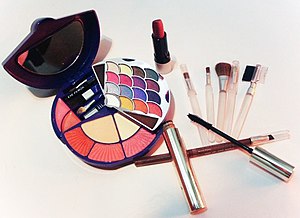Cosmetics are intended to enhance your appearance, but there are some dangerous chemicals that may be lurking in your make-up. Here are some of the more common toxic chemicals and the cosmetics where they can be found.

1. Lead
Once thought to be an urban legend, a recent study confirmed the presence of lead in some lipsticks. However, the amount of lead present is very small – FDA regulations restrict the amount of lead in a particular red dye, for instance, to twenty parts per million. Nonetheless, the lead is present, and cumulative effects from the daily use of lipstick should not be ruled out. The health risks of lead exposure are fairly well known, and include neurological and reproductive disorders.
See this article on Snopes.com for more on the cautionary emails you may be getting about lead in lipstick: http://www.snopes.com/medical/toxins/lipstick.asp
2. Antibacterial Substances
If you use antibacterial soap or hand sanitizer, you have already put antibacterial substances on your skin. But foundation, eye make-up, and concealers can contain these antibacterial additives as well. While they are intended to prevent the growth of bacteria in make-up, antibacterial additives have some potential health risks. For example, triclosan, an antibacterial and also a pesticide, is found in hand soaps and is now under investigation by the FDA as a possible endocrine disruptor.
Antibacterials don’t discriminate between beneficial and harmful bacteria. This can cause an imbalance where harmful bacteria outnumber the healthy bacteria, and infections can result. The eyes are especially vulnerable to this type of imbalance. Also, the constant exposure of microbes to antibacterials can create resistant bacteria that are nearly impossible to eradicate.
One way to help limit the problems associated with too many antibacterials is to use natural antibacterial products, sanitizers and essential oils. Click here for our picks for the best essential oils and natural products.
Other fabulous products that offer antibacterial properties without creating the imbalance describe here can be found at IHerb.com (click for $10 off your first order)
3. Phthalates
Phthaltes are fragrance carriers, so they are likely to be found in cosmetics that contain added scent. They have been preliminarily linked to autism, and due to their hormone-like activity in the body, phthalates have been implicated in premature breast development and other reproductive problems. There is also a possible link between phthalates and cancer.
4. 1,4-dioxane
You aren’t going to find this listed on any cosmetic ingredients label. That’s because this carcinogen is a by-product or contaminant that results from the manufacturing process. Cosmetics that contain sodium laureth sulfate and/or chemicals that end in “xynol” or “oleth” probably contain 1,4-dioxane. Solution? Scrutinize before you buy. Check the ingredients list of all your liquid soaps and shampoos to make sure they don’t contain sodium laureth sulfate or other 1,4-dioxanes. Many of the shampoos and soaps at IHerb.com are 1,4-dioxane free.
5. Formaldehyde
This pungent chemical is used in nail care products, eyelash adhesives, and hair styling products. Even if it is not added to the cosmetic article itself, formaldehyde can be released from cosmetic preservatives such as dimethyl-dimethyl. Formaldehyde has been linked to increased skin sensitivity and cancer.
6. Nitrosamines
Nitrosamines, like 1,4-dioxane, are not directly added to cosmetics. But some concealers, mascara, and baby shampoos may contain nitrosamines. These chemicals have been linked to cancer and birth defects. Nitrosamines form under certain chemical conditions as the cosmetic item breaks down over time.



